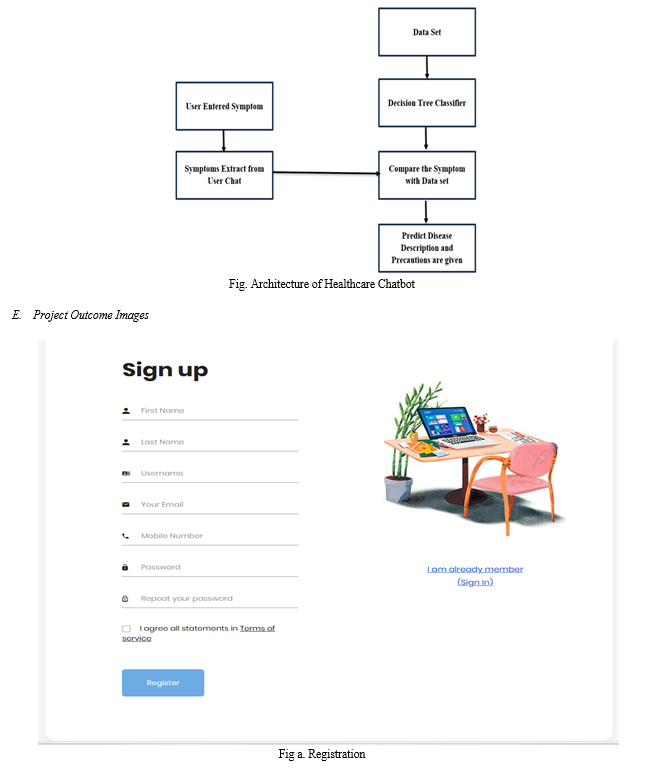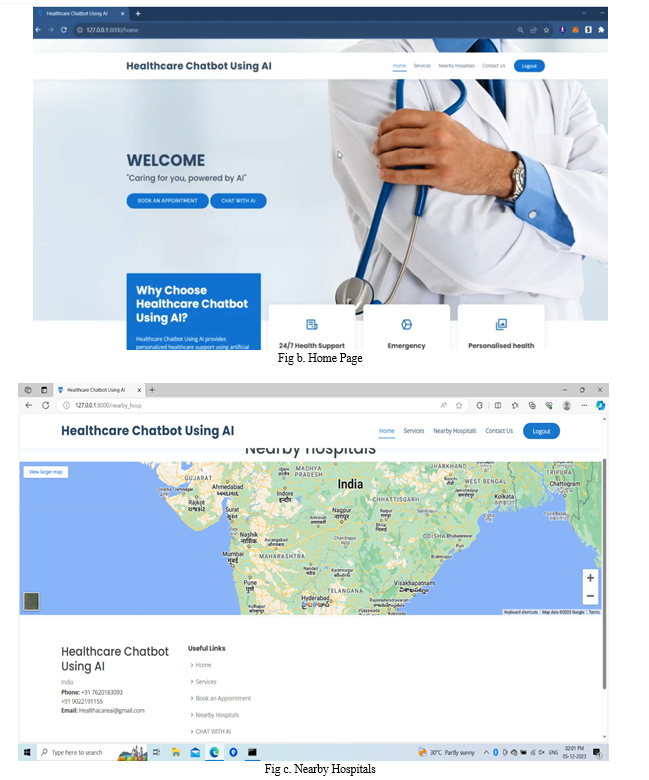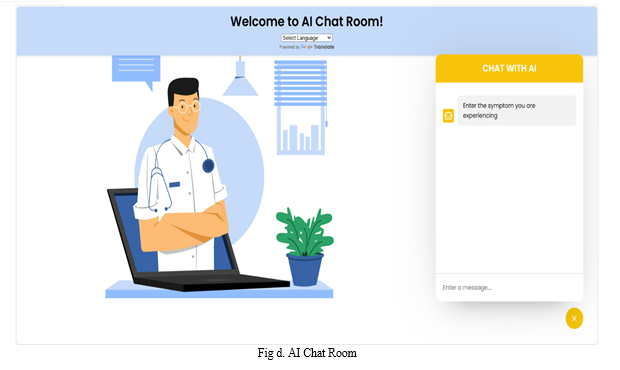Ijraset Journal For Research in Applied Science and Engineering Technology
- Home / Ijraset
- On This Page
- Abstract
- Introduction
- Conclusion
- References
- Copyright
Healthcare Chatbot Using AI
Authors: Ms. Puja D. Satpute, Ms. Shravani M. Babar, Ms. Aparna A. Magar, Ms. Gauri S. Kumbhar, Ms. Poonam N. Gore, Prof. Sachin D. Pandhare
DOI Link: https://doi.org/10.22214/ijraset.2024.61249
Certificate: View Certificate
Abstract
Medical chatbots mark a major advancement in patient care and dissemination of medical information. These AI-powered virtual assistants provide a variety of services, from providing medical information, facilitating appointments, and monitoring symptoms to providing psychological support and making it easier to find the nearest medical centre. It provides users with 24/7 access by easily advertising and pre-registering, improving user experience and making the healthcare process more efficient. Although medical chatbots have many advantages, it is important to know that their role is complementary rather than replacing, and therefore they should continue to be in the care of doctors. The report outlines the future of healthcare chatbots and highlights their potential to increase access and efficiency for patients and doctors.
Introduction
I. ACKNOWLEDGEMENT
Today on completion of this project work, the persons we need to thank the most who have helped us throughout the making of this project work and without those help the project would not have seen the light of the day.
Primarily, we submit our gratitude and sincere thanks to project guide Prof. S.D. Pandhare (Assistant Professor, Computer Science & Engineering), for their constant motivation and support during the course of the work for project. We truly appreciate and value their esteemed guidance and encouragement from the beginning to the end of this project work. We are thankful to our Head of the Departments Prof. S. D. Pandhare for their unwavering moral support and motivation during the entire course of the project work.
We would also like to thank our Principal Dr. P. A. Dhawale who encouraged us and created a healthy environment for all of us to learn in best possible way. We would like to thank all the staff members of our college and technicians for their help in making this project work a successful one. Last but not the least, We would like to thank all our Friends and Family members who have always been there to support and helped us to complete this project work in time.
??????I?I. INTRODUCTION
Healthcare chatbots use artificial intelligence technology and are complex computer systems designed to provide a variety of medical services through language processing. These chatbots are revolutionizing healthcare by offering a variety of services, such as sharing information, scheduling appointments, performing symptom assessments, and providing mental health services, and helping users find nearby medical facilities. They are effective when available around the clock, allowing users to easily access medical facilities and services while providing personalized answers and recommendations based on individual medical history, treatment and needs. Additionally, medical chatbots increase efficiency in routine work, allowing doctors to spend more time on patient care. Integration with electronic medical records helps provide a comprehensive overview of patient history, improving the accuracy of recommendations. It also encourages interactivity by integrating text boxes and choice lists, thus making user interaction easier. Although medical chatbots have many benefits, they cannot replace doctors and should be used for general information and initial guidance, not for diagnosis or treatment. Given that medical chatbots process sensitive medical information, ensuring privacy and data security is critical. Building user trust in AI-powered tools is a challenge, but important for widespread adoption. As technology continues to advance, medical chatbots will play an important role in healthcare and provide valuable support to patients and doctors.
III. OBJECTIVES
The aim of the program includes a positive approach to new treatments. First, it aims to promote collaboration with physicians and create effective partnerships to improve patient care through information sharing and collaboration. The program is also committed to promoting health and well-being by providing resources and interventions designed to help people stay healthy and prevent disease. It also focuses on enabling patients to easily store important information regarding their medical history and medical planning by providing easy and secure access to medical information. The plan also includes methods for assessing and classifying symptoms and using technology to assess and resolve personal health problems once they reach the appropriate level of care.
Finally, scalability and integration are considerations, and the program is designed to grow and expand seamlessly while integrating with existing healthcare systems to improve performance and performance.
???????IV. LITERATURE SURVEY
Mohammed Juned, Farhat Dalvi, Janhavi Kadam, Awais Khalifey, Sakshi Mane, Shaikh Mohd Ashfaque Long IEEE AI Healthcare Chatbot is proposed under the connected healthcare framework. The project is developed for the user to save the user their time in consulting the doctors or experts for the healthcare solution [1]. Aishwarya Kedar, Jyoti Dahale, Khushboo Patel, Shivani Lahamage (IEEE Member) Chatbot System for Healthcare using Artificial. Unlike existing chatbots which focused on various domains of healthcare. This is the best solution for people who are busy with their job schedules [2]. Vigneshwara C, Kunda Suchitra, Sareddy Nikhil Reddy, Rahul Manojkumar Makadiya IEEE they investigate a there are many algorithms which can be utilized for the chatbot, but it depends on what functions and needs we have and how we are going to design it [3]. Lekha Athota Student, Bachelor of Science Information Technology Amity University, Dubai, UAE lekhaA@amitydubai.ae Vinod Kumar Shukla Department of Engineering and Architecture Amity University, Dubai, UAE vshukla@amityuniversity.ae Nitin Pandey Amity Institute of Information Technology, Amity University Noida, UP, India npandey@amity.edu Ajay Rana AIIT, Amity University Uttar Pradesh Noida, India ajay_rana@amity.edu IEEE in this article, Here the studies are based on to recognize emotions classification using AI methods. The studies train emotions classification models from a lot of labelled data based on recurrent neural network (RNN), deep learning, and convolutional neural network. Linguistic interaction is most important in counselling using Natural Language Processing (NLP) and Natural-language generation (NLG) to understand dialogues of users. They have collected corpuses to learn semantic information of words and represent as vector using the word vector, synonym knowledge of lexical are collected [4].
???????V. SYSTEM MODELING
The plan focuses on several key goals aimed at strengthening all aspects of healthcare. First, it means improving patient education by promoting access to information that will enable people to make informed decisions about their health. By reducing the workload caused by repetitive tasks, doctors can devote more time to managing patients, thus increasing efficiency and quality of service. Additionally, the program emphasizes evidence-based practices and collaborative care to ensure health care is effective, personalized, and tailored to individual needs. It also improves overall patient outcomes and experiences by using advanced care technologies to support symptom assessment, early intervention, and intervention. Through these plans, the plans focus on positive changes in healthcare, ultimately benefiting patients and doctors.
A. Block Diagram

B. Description of Programming Languages
- Python: It is a general-purpose coding language which means that, unlike HTML, CSS, and JavaScript, it can be used for other types of programming and software development besides web development. Additionally, Python is widely utilized in various domains, including Natural Language Processing (NLP) and Artificial Intelligence (AI).
- NLP (Natural Language Processing): Natural language processing (NLP) refers to the branch of computer science—and more specifically, the branch of artificial intelligence or AI—concerned with giving computers the ability to understand the text and spoken words in much the same way human beings can.
- Flask: Flask is a micro web framework written in Python. It is classified as a microframework because it does not require particular tools or libraries.
- Django Framework: Django is a high-level Python web framework that encourages rapid development and clean, pragmatic design. It follows the "batteries-included" philosophy and includes many built-in features for web development, making it suitable for building complex, database-driven websites and applications.
- Artificial Intelligence: Artificial Intelligence (AI) involves the development of computer systems that can perform tasks that typically require human intelligence. Python is a popular choice for AI development due to its simplicity, versatility, and extensive libraries and frameworks tailored for machine learning, deep learning, and other AI applications.
C. Description of Libraries use
- Numpy: NumPy, which stands for Numerical Python, is a library consisting of multidimensional array objects and a collection of routines for processing those arrays. Using NumPy, mathematical and logical operations on arrays can be performed.NumPy is a Python package. It stands for ‘Numerical Python’. It is a library consisting of multidimensional array objects and a collection of routines for processing of array.
- Pandas: Pandas is an open source Python package that is most widely used for data science/data analysis and machine learning tasks. It is built on top of another package named Numpy, which provides support for multi-dimensional arrays. As one of the most popular data wrangling packages, Pandas works well with many other data science modules inside the Python ecosystem, and is typically included in every Python distribution, from those that come with your operating system to commercial vendor distributions like ActiveState’s ActivePython.
- Matplotlib: Matplotlib is a plotting library available for the Python programming language as a component of NumPy, a big data numerical handling resource. Matplotlib uses an object oriented API to embed plots in Python applications.
D. Implementation
Healthcare chatbots are software applications engineered to engage in dialogues with human users, primarily within the healthcare sector. They employ natural language processing (NLP) and artificial intelligence (AI) algorithms to comprehend user inquiries and furnish appropriate replies.
- Input the user's query into the chatbot interface.
- Extract information from user interactions.
- Utilize a Decision Tree classifier algorithm for query analysis.
- Retrieve responses from the chatbot database, such as Disease Prediction and Disease Precaution, and present them to the user.
- Terminate the interaction.
Although the decision tree classification algorithm is suitable for classification, it is a learning method suitable for both classification and regression. It works like a tree-like structure where nodes define properties of the data, branches represent operations, and each leaf represents the result.
There are two types of nodes in a decision tree: decision nodes and leaf nodes. Decisions facilitate the decision of many branches, while the leaf represents the final result without additional branches.


 ???????
???????
Conclusion
A. Conclusion In this survey, medical chatbots show a new way to solve many problems encountered in the healthcare industry. They provide patients with quick access to medical information and guidance while helping doctors improve patient outcomes. B. Future Scope With the advancement of technology, the future potential of medical chatbots and artificial intelligence is huge. By analyzing big data, these tools can predict health problems before they occur and potentially change a patient\'s health.
References
[1] Hiba Hussain1, Komal Aswani2, Mahima Gupta3, Dr. G.T.Thampi4,”Implementation of Disease Prediction Chatbot and Report Analyzer using the Concepts of NLP, Machine Learning and OCR,”IRJET,Apr 2020. [2] Kowatsch, T., M. Nißen, C.-H. I. Shih, D. Rüegger, D. Volland, A. Filler, F. Künzler, F. Barata, D. Büchter, B. Brogle, et al. (2017). Text-based healthcare chatbots supporting patient and health professional teams: preliminary results of a randomized controlled trial on childhood obesity. [3] Lin Ni(B), Chenhao Lu, Niu Liu, and Jiamou Liu,” MANDY: Towards a Smart Primary Care Chatbot Application”, SPRINGER,2017. [4] Divya, S., V. Indumathi, S. Ishwarya, M. Priyasankari, and S. K. Devi (2018). A self-diagnosis medical chatbot using artificial intelligence. Journal of Web Development and Web Designing, 3(1), 1–7. [5] Kavitha, B. and C. R. Murthy (2019). Chatbot for healthcare system using artificial intelligence. [6] Kandpal, P., K. Jasnani, R. Raut, and S. Bhorge, Contextual chatbot for healthcare purposes (using deep learning). In 2020 Fourth World Conference on Smart Trends in Systems, Security and Sustainability (WorldS4). IEEE, 2020. [7] A. F. Ur Rahman Khilji, S. R. Laskar, P. Pakray, R. A. Kadir, M. S. Lydia and S. Bandyopadhyay, \"HealFavor: Dataset and A Prototype System for Healthcare ChatBot,\" 2020 International Conference on Data Science, Artificial Intelligence, and Business Analytics (DATABIA), 2020. [8] HEALTHCARE CHATBOT 1Athulya N, 2 Jeeshna K, 3S J Aadithyan,4U Sreelakshmi,5Hairunizha Alias Nisha Rose College of Engineering Thalassery , India.
Copyright
Copyright © 2024 Ms. Puja D. Satpute, Ms. Shravani M. Babar, Ms. Aparna A. Magar, Ms. Gauri S. Kumbhar, Ms. Poonam N. Gore, Prof. Sachin D. Pandhare. This is an open access article distributed under the Creative Commons Attribution License, which permits unrestricted use, distribution, and reproduction in any medium, provided the original work is properly cited.

Download Paper
Paper Id : IJRASET61249
Publish Date : 2024-04-29
ISSN : 2321-9653
Publisher Name : IJRASET
DOI Link : Click Here
 Submit Paper Online
Submit Paper Online

